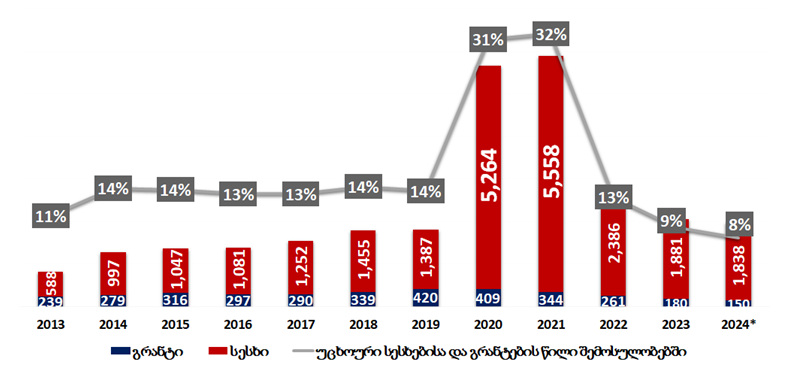Foreign loans and grants constituted 16% of the total state budget revenues between 2013 and 2023. Georgia received GEL 23 billion in credit and GEL 3.4 billion in grants from abroad over the aforementioned 11 years. Furthermore, an inflow of over GEL 2 billion is projected to be received from foreign sources as per the 2024 plan.
Foreign loans and grants have predominantly been intended for infrastructure projects with the exception of 2020-2021 when a larger share of the budget was allocated for pandemic response efforts. Almost a third of the budget came from foreign funding during this period, enabling the provision of some compensation for utility fees and support for the unemployed in addition to healthcare expenses.
Graph 1: Share of Foreign Loans and Grants in the State Budget (GEL million)

Source: Ministry of Finance of Georgia
Notably, international organisations comprised the majority of donors with foreign debt reaching USD 8.9 billion (GEL 24 million) as of 31 December 2023. Government debt amounted to USD 8.5 billion of the aforementioned figure whilst the National Bank’s debt totalled USD 402 million. The government debt of 6.4 billion is primarily owed to organisations such as the World Bank, Asian Development Bank, European Bank for Reconstruction and Development, European Investment Bank, International Monetary Fund and the European Union.
Graph 2: Multilateral Creditors as of 31.12.2023 (USD million)

Source: Ministry of Finance of Georgia
ADB – Asian Development Bank
IBRD – World Bank, International Bank for Reconstruction and Development
EIB – European Investment Bank
IDA – World Bank, International Development Association
EBRD – European Bank for Reconstruction and Development
AIIB – Asian Infrastructure Investment Bank
IMF – International Monetary Bank
EU – European Union
IFAD – International Fund for Agricultural Development
CEB – Council of Europe Development Bank
NEFCO – Nordic Environment Finance Corporation
The debt to individual countries reached USD 1.6 billion with 96% of the figure distributed amongst three countries: France, Germany and Japan. Furthermore, USD 500 million comprise Eurobonds. The National Bank had and continues to hold financial obligations only to the International Monetary Fund.
Graph 3: Bilateral Creditors as of 31.12.2024 (USD million)

Source: Ministry of Finance of Georgia
Proportionally, the share of multilateral creditors in the total state foreign debt constitutes 75%, bilateral creditors make up 19% whilst Eurobonds account for 6%. The debt of the National Bank, totalling USD 420 million, is excluded from the government debt representing 4% of the state debt.
Graph 4: Structure of State Foreign Debt

Source: Ministry of Finance of Georgia
It is planned to receive USD 150 million in foreign grants whilst foreign loans are projected to exceed USD 1.8 billion in 2024, constituting 8.6% of the total income. A total of USD 130 million out of the USD 150 million in grants were provided by international organisations whilst USD 20 million originated from other foreign governments. Notably, the European Union is the largest donor contributing USD 105 million.
The projected allocations to different sectors in the 2024 budget plan include GEL 17 million for the development of agriculture, GEL 12.6 million for vocational training, GEL 5.3 million for the rehabilitation of Tbilisi public schools, GEL 5 million for improving water supply in Ajara villages, GEL 2.3 million for the development of protected areas, GEL 2 million for rehabilitating schools in mountainous regions and GEL 1.6 million for the Kartli solid waste project.
It is noteworthy that Georgia is set to receive even larger amounts in the form of credit from abroad in addition to grants. The country is projected to receive GEL 135 million from the World Bank and GEL 134 million from the French Development Agency for the development of green policy. Additionally, GEL 86 million and GEL 27 million will be received from the aforementioned organisations within the human development programme. Moreover, the Asian Development Bank will allocate GEL 67 million for the development of the health sector.
The funds allocated to other large-scale projects are as follows:
1) The Asian Development Bank and the European Bank for Reconstruction and Development have allocated GEL 185 million to the Kvesheti-Kobi Road Project within the North-South Corridor.
2) The Asian Development Bank has allocated GEL 90 million to the Shorapani-Argveti Road Project on Tbilisi-Senaki-Leselidze highway.
3) The World Bank has allocated GEL 90 million to the Kakheti Connectivity Improvement Project.
4) The European Development Bank and the World Bank have allocated GEL 75 million to the Zemo Osiauri-Rikoti Pass section construction work within the East-West Highway Development Project.
5) The European Investment Bank and the European Union have allocated GEL 75 million to the Samtredia-Grigoleti section construction work within the East-West Highway Development Project.
6) The European Development Bank and the Asian Development Bank have allocated GEL 60 million to the Chumateleti-Khevi section construction work.
The Ministry of Regional Development and Infrastructure is set to receive the most funding from donors out of various institutions with expenditure with its total budget amounting to GEL 3.4 billion (GEL 18 million as grants and GEL 959 million as loans).
Notably, GEL 689 million out of the approximately GEL 1 billion credit will be assigned to road infrastructure improvement projects, GEL 73 million – for the rehabilitation of regional and municipal infrastructure and GEL 94 million for the rehabilitation and restoration of water supply infrastructure.
The draft law on Transparency of Foreign Influence was recently reintroduced in the Parliament and passed in the first reading on 17 April 2024 despite being withdrawn on its second reading in 2023. The aforementioned draft law does not require registration of state structures in the mandated register.







